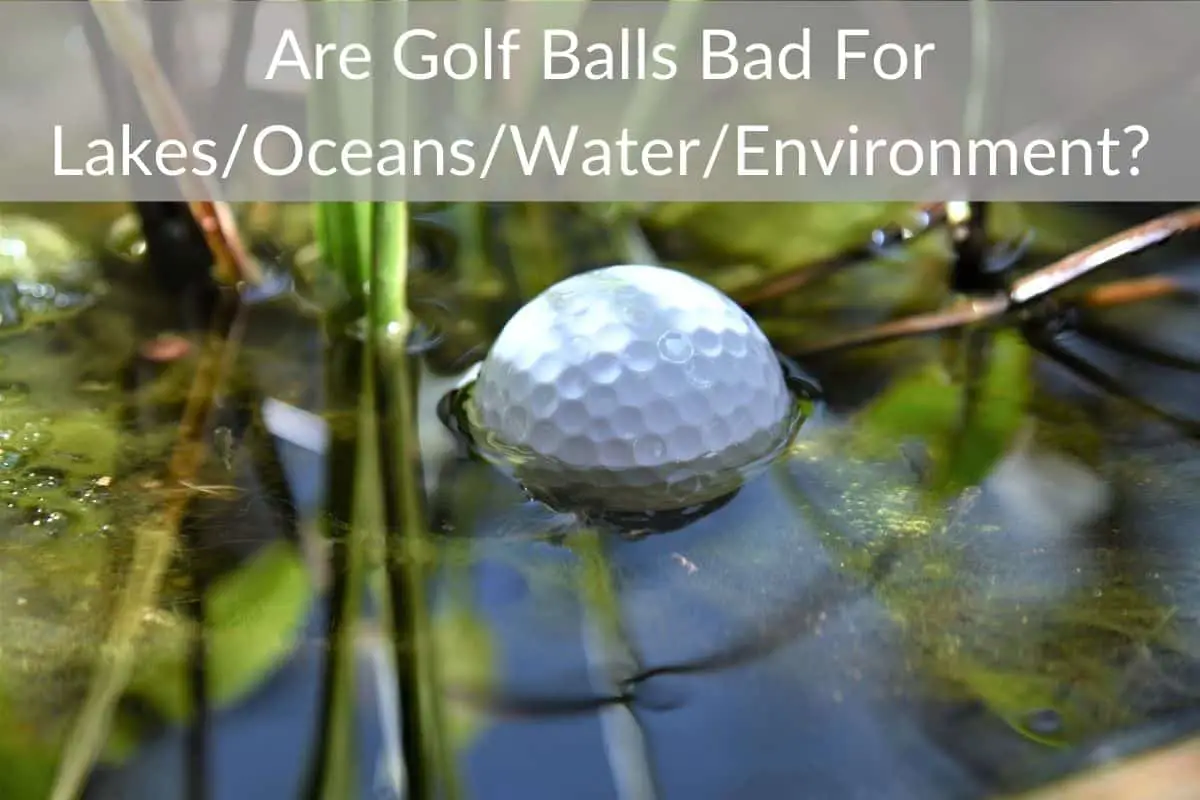Table of Contents
*This post may contain affiliate links. As an Amazon Associate we earn from qualifying purchases.
According to Healthline, playing golf can be healthy. Despite being slow-paced, it encourages regular aerobic activity and has even been linked to a lower death rate.
However, while golf may be good for your heart, it’s not really that good for the environment. With hundreds of thousands of golf balls being found in both freshwater and saltwater sources, there’s clear evidence that the answer to the question, “Are golf balls bad for the environment?” is a resounding yes.
Golf balls are essentially litter that can be found in both fresh and saltwater so they are bad for the environment and those bodies of water. These golf balls will eventually leach plastic into the water causing issues for it and its ecosystem.
So, how exactly has this wonderful sport of golf become associated with so much pollution? Why are golf balls dangerous for the ocean, and what is being done to remedy this problem?
In this article, I will try to tackle all these issues and more.
To see some of the latest and greatest golfing gadgets currently on the market just click here.
Into the Ocean Instead of Into the Hole
While we have known about plastic in the ocean for years, there wasn’t a particular emphasis on golf balls and their impact on marine life until a 2019 research paper was published in Marine Pollution Bulletin.
According to the research paper, the team collected 39,602 golf balls from coastal environments associated with five golf courses in California from May 2016 to June 2018.
When efforts were helped by the Monterey Bay National Marine Sanctuary and the Pebble Beach Corporation, this came to a total of 50,681 golf balls until the paper was published.
This equalled approximately 2.5 tons in debris. The researchers have estimated that almost 62lbs of material eroded from the balls they recovered.
Of course, while the incident at Pebble Beach Golf Links is one of the most popular ones, it is by no means the only instance of golf balls being littered throughout our waters.
This was highlighted in Scotland when researchers were examining Loch Ness to find evidence of the loch’s mythical monster. Instead of this, they discovered hundreds of thousands of golf balls at the bottom of the loch.
Arcadia Bluffs, a golf course overlooking Lake Michigan, even encouraged its members to launch golf balls into the lake in 2019, saying, “Go ahead and do it, everyone does.” While the course removed this from the website after significant backlash, past employees have deemed it a common practice.
The Dangers That Golf Balls Pose To The Environment
Despite the ever-increasing scale of the problem, people continue to ask, “Are golf balls bad for the ocean?” because they don’t fully grasp how these synthetic objects can cause damage. The answer is simple: golf balls don’t sit in one place.
They get moved around, and they corrode, causing environmental damage and even endangering marine life.
Are Golf Balls Biodegradable?
Research from the Danish Golf Union has shown that golf balls take about 100-1000 years to decompose naturally. With 300 million balls lost in the U.S. alone and plenty of these ending up in our waters, this means that the golf balls will be sticking around for a long time.
Normal golf balls are not biodegradable and since they last for 100-1,000 years they will stay in the ocean, lake, or woods for long after the player that put them there is gone. However you can buy golf balls that are biodegradable if you choose to do so.
Traditional golf balls contain not only plastics like polyurethane but also synthetic rubber polymers and resins. Instead of degrading like other substances, all these golf balls do is break down and spread plastics and other waste deep into the ocean or lakes.
Some golf balls found in the ocean are more than 15 years old. This is known because of their wound-style construction that hasn’t been seen since the late 1990s. Because the rubber threads in these balls are buoyant, they tend to float and get tangled in kelp, and end up hurting marine life.
Are Golf Balls Toxic?
Many people don’t understand the problem since they don’t think of golf balls as toxic. However, they don’t understand that the decomposition process involves golf balls being dissolved and thoroughly breaking down.
During this process, the balls leak petroleum and high levels of heavy metals such as zinc which can then attach to the ground and poison marine life and plant forms.
Golf balls aren’t toxic to humans but as they begin to break down on land or in water the plastic and chemicals that they give off can harm marine life.
Therefore, in addition to worsening the microplastic problem, golf balls in the ocean also leak chemical pollutants.
The Golf Ball Threat to Marine Life
For every 1000 golf balls in the ocean, multiple pounds of microplastic contaminate the ocean and threaten marine life. These particles can disturb cellular function and disrupt the behavior of different organisms.
In addition to being found in the stomachs of dead gray whales, golf balls have also been seen in bird stomachs.
Sometimes, golf balls can enter birds’ reproductive tracts and can be found in the eggs they lay. One popular instance was that of a Canada goose laying an egg with a golf ball inside.
The Golf Ball Microplastic Problem
Golf balls may seem fairly durable, but this changes over time when they’re underwater. Even if we don’t factor in the heavy metal pollution, golf balls still release microplastic into the ocean.
This ends up in the stomachs of marine animals and humans when we consume seafood.
According to a study by the University of Newcastle, the average person could be ingesting as much as 5 grams of microplastic a week – almost as much as eating a credit card!
Every week!
Final Thoughts
Despite clean-ups taking place, golf balls are accumulating in the water faster than they’re being removed.
According to Hakai Magazine, the planet has over 32,000 golf courses, with many of them situated next to the ocean. With approximately one billion golf balls lost every year, a lot of this plastic (almost 100 million pounds worth) is bound to end up in the ocean.
It’s up to golf courses, regulatory bodies, and individuals to make an effort to reduce this massive littering problem.
Sometimes bad shots happen, and you lose a ball or two. However, if you’re playing near bodies of water and can’t keep your balls on the fairway, we would suggest investing in biodegradable golf balls so that you can minimize your environmental footprint.
Some biodegradable golf balls dissolve in the water after a few minutes, while others are constructed to contain ingredients to feed wildlife and safeguard the environment.
Whichever ones you choose, you’re helping to do your part in preventing the spread of toxic chemicals into the ocean.

